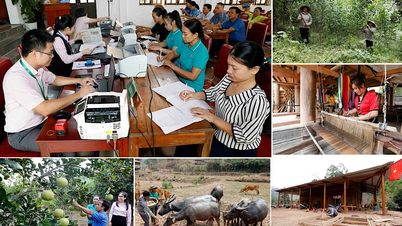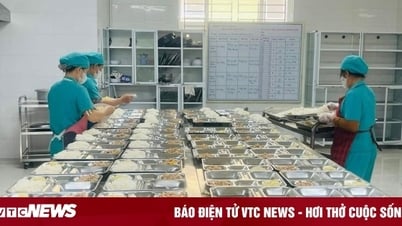Master raw materials, increase product quality
According to Dr. Le Duy Binh, Director of Economica Vietnam, the development of export markets for key commodity groups is not really sustainable and is vulnerable to changes in the international environment as well as changes in policies of import markets.
And one of the limitations of this process is that Vietnam has not really been proactive in the supply of raw materials.

Vietnam needs to master raw materials to increase value instead of just processing. (Illustration photo).
“The dependence on imported raw materials and outsourcing production is a major limitation to the goal of sustainable development of key industries. Without enough raw materials, businesses will find it difficult to meet order progress and may miss many golden opportunities in export.
In addition, businesses need to proactively produce raw materials to meet origin requirements, increase export added value and take advantage of tax incentives, especially when participating in free trade agreements," said Mr. Binh.

soldier.jpg
Without enough raw materials, businesses will find it difficult to meet order progress and may miss many golden opportunities in export.
Dr. Le Duy Binh
Therefore, according to Mr. Binh, businesses need to develop the supply of raw materials to produce key export products such as phones and components, computers, electronic products and components, textiles, footwear, etc. to gradually reduce the import of input materials.
After proactively supplying raw materials, businesses also need to have a strategy to create a stable and quality supply, helping businesses ensure the progress of orders and ensure the quality of output products.
“If input materials are produced domestically, they will be of special importance, because they will create jobs, increase income for workers, and confirm the origin of goods in Vietnam, ensuring the regulations of many international partners,” said Dr. Binh.
In particular, Mr. Binh further analyzed, this is also a way to prove that Vietnamese goods are not being dumped, because domestically produced raw materials along with relatively low labor costs have created a suitable export price.
“In the long run, this will help Vietnam minimize risks from trade defense investigations,” he said.
Meanwhile, economic expert Nguyen Minh Phong emphasized the role of increasing the quality and value of exported goods.
According to Mr. Phong, in order to sustainably develop the export market of key products, these products themselves must ensure quality to compete fairly with goods from other countries. Once quality is guaranteed, it is easy to increase product value and conquer any market.
To do so, businesses must improve quality sustainably by improving products, researching and developing new products, meeting the current trend of clean, green, and environmentally friendly products.
In the long term, businesses need to invest in building and affirming their brands, increasing the value of their exports. Because the trend of consumers in the world today is that buyers always aim for products with brands, prestige and high quality. Once they have won the trust of consumers, they can protect the goal of strongly developing the export market of key products.
Expand export markets immediately
Diversifying export markets to avoid dependence on any market is considered by many experts to be the most urgent measure to implement the strategy of developing export markets for key products.
Experts warn that Vietnam is still heavily dependent on a few major export markets. Therefore, when these countries fall into crisis or change their import and tariff policies, Vietnam's export activities will face major shocks and even the risk of disruption.

Vietnam needs to diversify markets for key export products. (Illustration photo).
National Assembly Delegate Nguyen Quang Huan, Vice Chairman of the Vietnam Private Entrepreneurs Association - Chairman of the Board of Directors of Halcom Vietnam Joint Stock Company, cited: For example, if Vietnam's key products depend too much on large markets like the US, they will face great risks when this country has sudden changes in policies or tariffs. And when these products are affected in the export process, it will have a very negative impact on the export results of the economy in general and on the goal of developing export markets for key products in particular.
“Not only the US but any other market can change its policy, in the context of increasing global trade tensions. This can directly affect the long-term profits of businesses and the entire economy, so it is imperative to quickly diversify export markets,” warned delegate Huan.
Delegate Huan recommended that Vietnam should negotiate and sign more trade agreements with other countries to expand market access and reduce dependence on a few large markets, thereby stabilizing export opportunities.
Agreeing with the above opinion, Dr. Nguyen Bich Lam, former General Director of the General Statistics Office, further emphasized that the basis for market expansion must also be based on the capabilities of each enterprise in a specific context. For example, small and medium enterprises should choose less risky and more stable markets such as the EU, Japan, ASEAN, Africa, etc.

Nguyen Bich Lam.jpeg
The basis for market expansion must also be based on the capabilities of each business in a specific context.
Dr. Nguyen Bich Lam
Mr. Lam cited the leather and footwear industry as an example, with the target of reaching a turnover of about 29 billion USD in 2025, a growth of 10% compared to 2024, and the textile and garment industry setting an export target of 47 - 48 billion USD (an increase of 3 - 4 billion USD compared to 2024).
In addition to major markets such as the US, EU, and China, these key industries must strive to expand into South American and Middle Eastern markets. Businesses need to be wary of large markets that often have their own development policies. For example, the US government always aims for “fair trade”, which means reducing the trade deficit as much as possible. Therefore, this “big guy” is likely to change tariffs to achieve this.
Associate Professor, Dr. Pham Thi Hong Yen, member of the National Assembly's Economic and Financial Committee, also expressed her opinion that in order to develop the export market for Vietnam's key products such as textiles, footwear, wood products, agricultural, forestry and fishery products, etc., it is necessary to expand and diversify the market. That is, the more and more diverse the customers are, the greater the opportunity to maintain and expand market share.
To do this, Ms. Yen believes that businesses need to seek the assistance of Vietnamese trade agencies abroad, form business representatives and associations in new markets, and determine the best distribution channels to connect with, such as supermarkets, importers, distributors, or agents abroad...
On the other hand, businesses must participate more in trade promotion activities and international trade connections to increase opportunities to find suitable new markets.
“In particular, when finding potential importers, Vietnamese businesses need to carefully study their regulations and product quality standards to comply and effectively implement them,” said Ms. Yen.
According to the General Statistics Office, in the first quarter of 2025, the total import and export turnover of goods reached 202.52 billion USD, an increase of 13.7% over the same period last year, of which exports increased by 10.6%; imports increased by 17.0%.
There are 18 items with export turnover of over 1 billion USD, accounting for 84.5% of total export turnover, of which 5 items have export turnover of over 5 billion USD, namely: Electronics, computers and components; Phones of all kinds and components; Machinery, equipment, tools, other spare parts; Textiles and garments; Shoes and sandals.
Source: https://vtcnews.vn/muon-phat-trien-thi-truong-xuat-khau-nganh-hang-chu-luc-viet-nam-can-lam-gi-ar938581.html


![[Photo] Ready for the top competitions of Vietnamese table tennis](https://vphoto.vietnam.vn/thumb/1200x675/vietnam/resource/IMAGE/2025/5/18/9c547c497c5a4ade8f98c8e7d44f5a41)




![[Photo] General Secretary To Lam visits exhibition of achievements in private economic development](https://vphoto.vietnam.vn/thumb/1200x675/vietnam/resource/IMAGE/2025/5/18/1809dc545f214a86911fe2d2d0fde2e8)




















![[Photo] National conference to disseminate and implement Resolution No. 66-NQ/TW and Resolution No. 68-NQ/TW of the Politburo](https://vphoto.vietnam.vn/thumb/1200x675/vietnam/resource/IMAGE/2025/5/18/adf666b9303a4213998b395b05234b6a)






























































Comment (0)